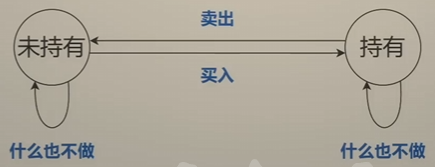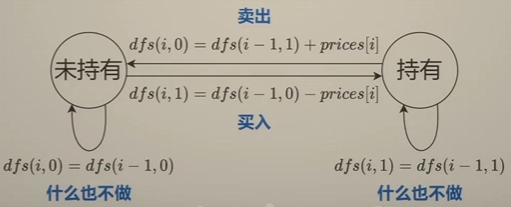122. 买卖股票的最佳时机 II
题目
给你一个整数数组 prices ,其中 prices[i] 表示某支股票第 i 天的价格。
在每一天,你可以决定是否购买和/或出售股票。你在任何时候 最多 只能持有 一股 股票。你也可以先购买,然后在 同一天 出售。
返回 你能获得的 最大 利润 。
示例 1:
输入:prices = [7,1,5,3,6,4]
输出:7
解释:在第 2 天(股票价格 = 1)的时候买入,在第 3 天(股票价格 = 5)的时候卖出, 这笔交易所能获得利润 = 5 - 1 = 4 。
随后,在第 4 天(股票价格 = 3)的时候买入,在第 5 天(股票价格 = 6)的时候卖出, 这笔交易所能获得利润 = 6 - 3 = 3 。
总利润为 4 + 3 = 7 。示例 2:
输入:prices = [1,2,3,4,5]
输出:4
解释:在第 1 天(股票价格 = 1)的时候买入,在第 5 天 (股票价格 = 5)的时候卖出, 这笔交易所能获得利润 = 5 - 1 = 4 。
总利润为 4 。示例 3:
输入:prices = [7,6,4,3,1]
输出:0
解释:在这种情况下, 交易无法获得正利润,所以不参与交易可以获得最大利润,最大利润为 0 。提示:
1 <= prices.length <= 3 * 10^40 <= prices[i] <= 10^4
解答
思路:状态机记忆化搜索
买卖股票问题是典型的 状态机 DP 问题,可分为两类:
- 不限交易次数
- 至多/恰好/至少交易
次
本题是不限交易次数的类型。为了方便改成递推,我们推荐思考记忆化搜索时采用从最后一天往前思考的方式,我们思考最后一天发生了什么。其中股票的价格如下:
python
prices = [7, 1, 5, 3, 6, 4]从第 0 天开始到第 5 天结束时的利润 = 从第 0 天开始到第 4 天结束时的利润 + 第 5 天的利润。关键在于到第 5 天时手上是否持有股票。
回溯三问:
- 当前操作:在第
天能做的事情 - 什么都不做
- 买入股票
- 卖出股票
- 当前问题:
- 到第
天结束时,且 持有股票 时的最大利润 - 到第
天结束时,且 未持有股票 时的最大利润
- 到第
- 它的子问题:
- 到第
天结束时,且 持有股票 时的最大利润 - 到第
天结束时,且 未持有股票 时的最大利润
- 到第
状态机图:

定义状态和状态转移方程:
dfs(i, 0)表示到第天结束时,且 未持有股票 时的最大利润 dfs(i, 1)表示到第天结束时,且 持有股票 时的最大利润 max(dfs(i, 0), dfs(i, 1))表示第天开始时的最大利润
状态转移方程:

递归边界:
dfs(-1, 0) = 0表示第 0 天开始且没有持有股票,利润为 0dfs(-1, 1) = -inf表示第 0 天开始且持有股票,这是不可能的,因此所有由它转移得到的答案都是错的,于是把它的利润设置为负无穷
递归入口:max(dfs(n - 1, 0), dfs(n - 1, 1)) = dfs(n - 1, 0)
代码
python
class Solution:
def maxProfit(self, prices: List[int]) -> int:
n = len(prices)
@cache
def dfs(i, hold):
if i < 0:
return -inf if hold else 0
if hold:
return max(dfs(i - 1, True), dfs(i - 1, False) - prices[i])
return max(dfs(i - 1, False), dfs(i - 1, True) + prices[i])
return dfs(n - 1, False)思路:递推
原始递推式:
防止负下标:
起始值:
答案:
代码
python
class Solution:
def maxProfit(self, prices: List[int]) -> int:
n = len(prices)
f = [[0] * 2 for _ in range(n + 1)]
f[0][1] = -inf
for i, p in enumerate(prices):
f[i + 1][0] = max(f[i][0], f[i][1] + p)
f[i + 1][1] = max(f[i][1], f[i][0] - p)
return f[n][0]思路:空间优化
f[i] 只用到了 f[i - 1][0], f[i - 1][1],因此用两个数字滚动计算即可。
代码
python
class Solution:
def maxProfit(self, prices: List[int]) -> int:
n = len(prices)
f0 = 0
f1 = -inf
for p in prices:
new_f0 = max(f0, f1 + p)
new_f1 = max(f1, f0 - p)
f0 = new_f0
f1 = new_f1
return f0